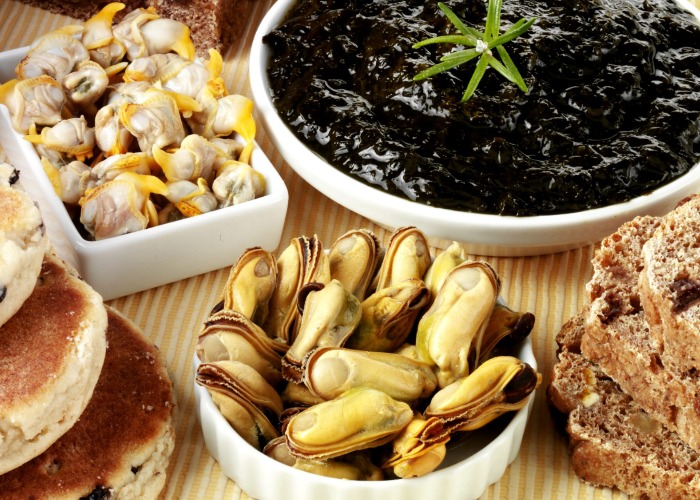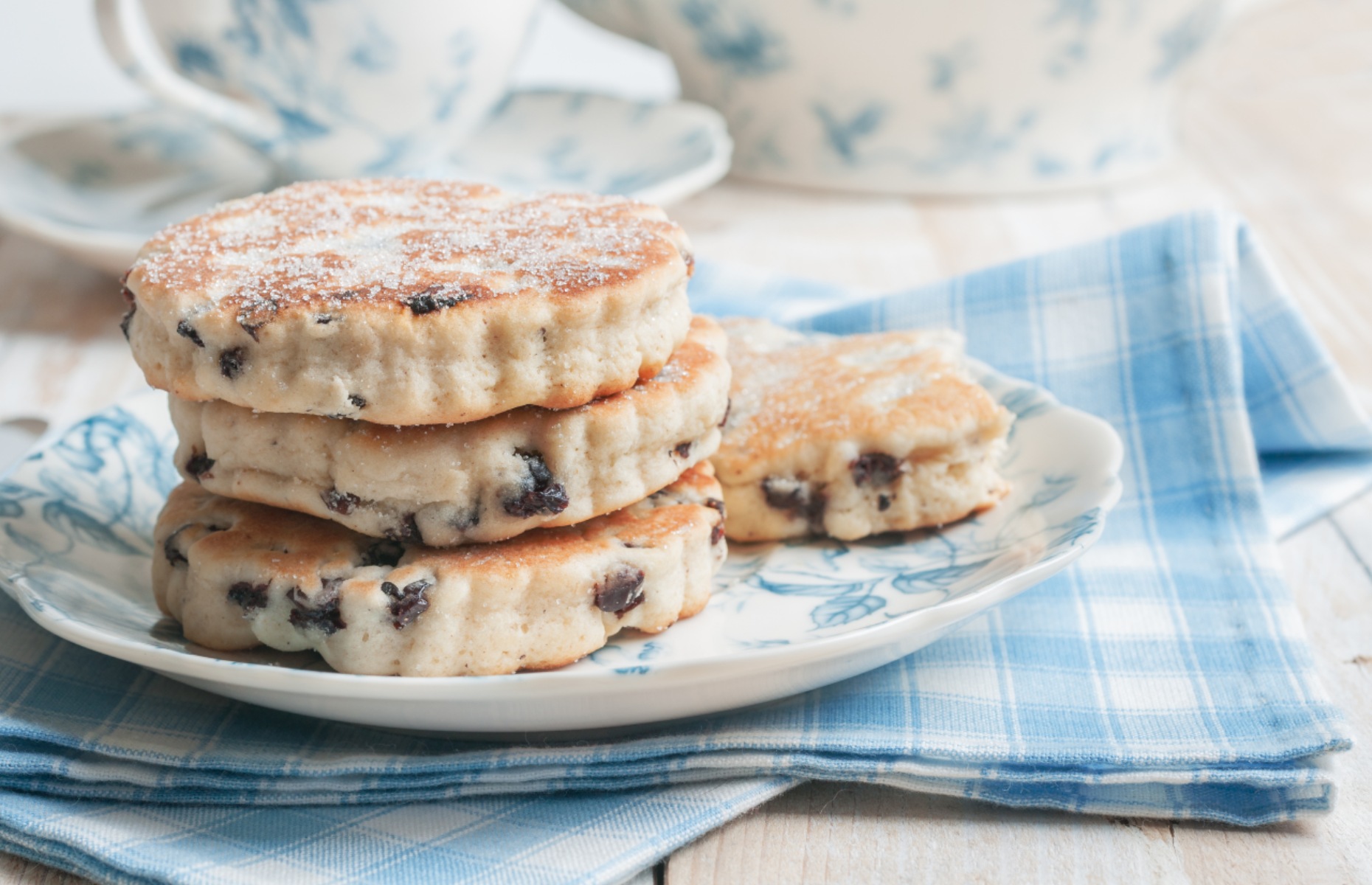
While Wales has a vibrant restaurant scene today, its traditional delicacies are a triumph of simple, resourceful cooking that's all about maximising flavour and nutrition using the ingredients to hand.
Little attention was paid to the origins of family staples like cawl and bara brith until recently, as classic Welsh dishes were very much food of the people, with each family having their own special twist on the recipes.
Chef and food writer Gilli Davies-Cliff, author of Flavours of Wales, says: “Traditional Welsh recipes interest me in two ways. Firstly, Wales, with its long coastline and upland topography, hosts some quite unusual ingredients such as laverbread and exceptional mountain lamb. But the Celtic history of Wales has brought it a diversity of recipes not found elsewhere in Great Britain.”
Here are 10 of our favourite Welsh treats that you need to try.
1. Welsh cakes

No other sweet bake compares to a Welsh cake – these flat treats are browned on a cast-iron bakestone over the stove rather than cooked in an oven and have a melt in the mouth texture. “No other Celtic country makes Welsh cakes, although Scotland has oatcakes and Ireland potato cakes,” says Davies-Cliff.
Known as pice ar y maen in Welsh, they became especially popular in the 19th century as a delicious way to use up basic ingredients – butter, lard, or margarine with flour, eggs, sugar and currants. Recipes vary between families, however, and some will add cinnamon or nutmeg. They can be eaten hot or cold, but few will argue that Welsh cakes are best enjoyed still warm and sprinkled with sugar, without any additions like butter or jam.
2. Glamorgan sausages
Long before Linda McCartney, the Welsh were making their own veggie bangers from cheese, leeks and breadcrumbs. While their origins are a mystery and the earliest recipes include pork, it is likely that the name came from the inclusion of Glamorgan cheese, sadly no longer produced because the cattle are near-extinct.
The first recorded mention of selsig morgannwg, as it's called in Welsh, was in George Borrow’s book Wild Walls in 1850, but their popularity soared during the Second World War when meat was scarce due to rationing. The sausages are bound with egg and fried in a pan, with some chefs adding mustard or spices to the mixture and Caerphilly cheese is also favoured these days.
3. Bara brith
This ‘speckled bread’ flavoured with dried fruit, spices and tea is enjoyed sliced with a spread of butter and a cuppa – and Prince Charles is said to be rather partial to it. Bara brith is made by combining flour, yeast, butter, egg, mixed spices and fruit, with the latter often soaked in tea overnight, otherwise you throw in a cold cuppa.
When Welsh settlers arrived in Argentina’s remote Patagonia in the 19th century, they took the recipe with them and locals now call it ‘torta negra’, meaning black cake. More recently, bara brith flavours have been used to enhance all sorts of other foods, such as chocolates, ice cream and even gin.
4. Brains SA
Cardiff-based S.A. Brain & Co is the best-known brewery in Wales, remaining in the hands of the Brain family since it was founded in 1882. Its original tipple was Brains Bitter but its most popular is Brains SA, with the first pint poured in 1958.
Stronger than its forefather but still very easy to drink, the beer has a nutty taste that has fuelled many a day at the rugby. The origins of its name are lost in the mists of time (probably after a few too many pints), so debate continues to rage over whether the SA stands for brewery founder Samuel Arthur, the literal Special Ale or the humorous Skull Attack.
5. Caerphilly cheese
This tangy white cow’s milk cheese was a favoured fromage in South Wales from at least the Middle Ages, but its origins remain hazy and the name is thought to come from where it was sold rather than produced. Cheesemonger and author Ned Palmer, who started his career selling Wales’ only native ‘caws’ in London's Borough Market, says: “Caerphilly is to the Welsh what Cheddar is to the English.”
“Many farmers up until the Second World War farms would skim the milk for cream to make butter and use the skimmed milk to make cheese, both these could be sold at market in a minimum of weeks,” says Davies-Cliff. But farmhouse Caerphilly production was dramatically halted during the war when milk was diverted to make the easier-to-store Cheddar.
Luckily, it was revived in the 1980s to combat poorer versions made by Cheddar producers in the West Country. Gorwydd, Duckett’s and Caws Cenarth are the main artisan producers today and Traditional Welsh Caerphilly has had PGI status since 2017.
READ MORE: Our best cheese recipes
6. Crempogs
Not only is their name a delight, but these pancakes are delicious to eat too. Made with buttermilk, they are thicker than English pancakes and French crêpes, having more in common with a Scotch or American one. They are usually served in a stack with butter and honey, rustled up for Pancake Day and other celebrations, and sometimes sliced like a cake.
Believed to be one of the oldest foods in Wales, crempogs would have been made on a bakestone and the name has been linked with the Bretton word for pancake, krampouezh. The English word ‘crumpet’ might be a derivative too.
7. Cawl
Every Welsh family will have a variation on this soothing slow-cooked stew, which is also known as ‘lobscaws’ or ‘lobscouse’ in the north. It’s most commonly made with lamb or mutton but would be prepared with whatever was at hand in times past, such as seafood, beef or bacon. Cabbages, leeks and potatoes are staples too, but the vegetable element has also evolved over time, as crops changed.
Cawl was first recorded in the 14th century, when it was prepared in a pot over an open fire for many hours to infuse the flavours and soften the meat. Today, it is usually eaten in one bowl with bread but can also be served as a two-course meal of broth followed by meat and vegetables, eaten with a wooden love spoon.
8. Laverbread
Don’t be fooled by the name. Laverbread is not a dough-based delicacy but a seaweed dish that inspires Marmite-like levels of love and hate due to its distinctive taste and texture. Dubbed ‘Welshman’s caviar’ by actor Richard Burton, it’s rich in both flavours of the sea and levels of iron and iodine, served as part of a fried breakfast to fuel malnourished miners back in the day.
Cultivation of laver seaweed, a type of red algae, is thought to be an ancient practice on Britain’s west coast but the first official record was in the 17th century. The laver is plucked from rocks and once it has been washed repeatedly to remove sand, it is boiled to make a gelatinous green puree.
Welsh Laverbread was awarded PDO-status in 2017 and with seaweed hailed as the climate-friendly super crop of the future, expect laverbread on your restaurant menu soon.
READ MORE: How to cook with seaweed
9. Conwy mussels
This seasonal seafood delicacy from the North Wales fishing village of Conwy is the result of a magical marriage of conditions and human care. The village sits on an estuary where the River Conwy meets the Irish Sea, meaning these particularly plump molluscs grow in a combination of fresh water and salty sea water, where they have plentiful plankton to feed on.
Locals treat their mussels with respect, gently harvesting them with wooden rakes from natural beds as they sit in small shallow bottomed boat called dory. Only four families are trained in these old-fashioned methods and in 2016, Conwy mussels received PDO status.
10. Welsh rarebit
This elaborate take on cheese on toast was originally called Welsh rabbit, a name given by wealthier English types to mock impoverished families across the border for whom meat was scarce. In her 1747 book The Art of Cookery, Hannah Glasse shares recipes for Scotch and English ‘rabbit’ too, but it is the Welsh one that has stood the test of time.
Baked cheese has been a Welsh passion since the Middle Ages and a classic rarebit involves making a thick sauce with cheese, mustard, beer, Worcestershire sauce and perhaps cayenne pepper or paprika. Some cooks use butter and flour to make a roux too. Gilli says: “Welsh rarebit in the past, as it is now, is a quick and nutritious way to feed the family.”
READ MORE: Best traditional Yorkshire food and drink
Lead image: CKP1001/Shutterstock